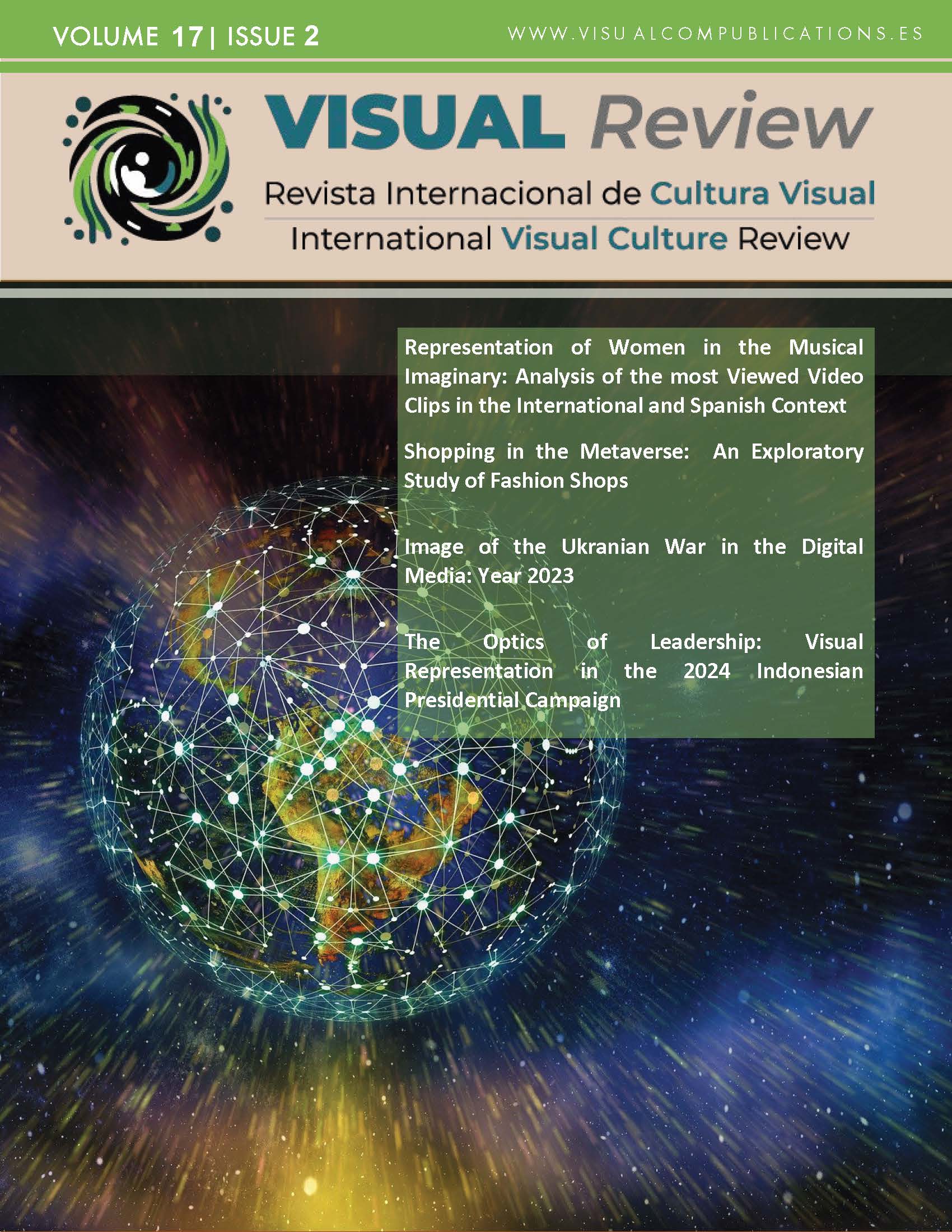The Case of TVG and TV3 on Instagram and Facebook
Exploitation of its Fiction Series as Transmedia Content
DOI:
https://doi.org/10.62161/revvisual.v17.5759Keywords:
Social Networks, Transmedia, Transfiction, Serial fiction, Regional Television, Public service, Regional languageAbstract
Derived from the crisis of the public service system in all areas and mainly the case of television, and under the premise of focusing on the shortcomings and possibilities that must be faced in the process of digitalization of society and consumption of audiovisual content, in this study the Spanish regional channels TVG and TV3 will be analyzed in the exploitation of their fiction series and mainly the transmedia carried out by them through their social networks; Facebook and Instagram.
Downloads
Global Statistics ℹ️
|
262
Views
|
213
Downloads
|
|
475
Total
|
|
References
Asión-Suñer, L. (2022). El diseño modular en la creación de productos para prosumer. Universidad de Zaragoza.
Azpillaga, P. (2000), Televisión, identidad y desarrollo regional, Televisión y desarrollo de las regiones en la era digital. Junta de Extremadura. Badajoz.
Ballesteros Herencia, C. (2018). El índice de engagement en redes sociales, una medición emergente en la Comunicación académica y organizacional. Razón y Palabra. Madrid.
Bauman, R. (2014). A World of Others' Words: Cross‐Cultural Perspectives on Intertextuality. Blackwell, Oxford.
Bauman, Z. 2018. Generación líquida: Transformaciones en la era 3.0. Paidós. Madrid.
Calvo, L. M. (2018). Periodismo transmedia: la adaptación a los nuevos tiempos de la comunicación. EUNSA. Navarra.
Campos Freire, F. (2008). Las redes sociales trastocan los modelos de los medios de comunicación tradicionales. Revista Latina de Comunicación Social. DOI: 10.4185/RLCS-63-2008-767-287-293.
Cantero, J. I., Sidorenko, P. y Herranz, J. M. (2018). Realidad virtual, contenidos 360o y periodismo inmersivo en los medios latinoamericanos. Una revisión de su situación actual. Contratexto, (29). http://bit.ly/2K5KKlt .
Carlón, M. & Scolari, C. A. (2009). El fin de los medios masivos. El comienzo de un debate. La Crujía. Buenos Aires.
Casado, M. Á. (2005). Nuevas estrategias para el desarrollo del sector audiovisual en las comunidades autónomas. Ámbitos. Revista Internacional de Comunicación, (13-14). https://revistascientificas.us.es/index.php/Ambitos/article/view/9583/8381 .
Costa, C. (2013). Narrativas transmedia nativas: ventajas, elementos de planificación de un proyecto audiovisual transmedia y estudio de caso. Historia y Comunicación Social, 18, Especial Diciembre. http://dx.doi.org/10.5209/rev_HICS.2013.v18.44349 .
Costa, C. y Piñeiro, T. (2012). Nuevas narrativas audiovisuales: multiplataforma, crossmedia y transmedia. El caso de Águila Roja (TVE). Icono, 2(10). http://dx.doi.org/10.7195/ri14.v10i2.156
Doyle, G. (2010). From Television to Multi-Platform. Less from More or More for Less?. Convergence.The International Journal form Research. 16(4):431-449. DOI:10.1177/1354856510375145.
Evans, E. (2011). Transmedia Television. Audiences, New Media and Daily Life. Routledge. New York.
Francés, M. y Orozco Gómez, G. (2017) La televisión de proximidad en el entorno transmedia. Síntesis. Madrid.
Galán, E. , Rodríguez, A. y Marzal, J. (2018). Contenidos transmedia para la radiotelevisión de proximidad. EUNSA. Navarra.
Galán, E. y Herrero, B. (2011). El guion de ficción en televisión. Síntesis . Madrid.
Herreros Cebrián, M. (2014). El periodismo entre la convergencia e interconexiones de las redes sociales. Fragua. Madrid.
Jenkins, H. (2009). The Revenge of the Origami Unicorn: Seven principles of transmedia storytelling” [web]. http://bit.ly/1ib6AvH.
Jenkins, H. (2010). Piratas de Textos: Fans, cultura participativa y televisión. Paidós. Madrid.
Kinder, M. (1991). Playing with Power in Movies, Television, and Video Games: From Muppet Babies to Teenage Mutant Ninja Turtles. Paperback.
Larrondo, A. (2016). El avance de las televisiones públicas autonómicas en el escenario convergente: análisis de experiencias periodísticas transmedia en EITB y CCMA. Communication & Society. Universidad de Navarra. DOI 10.15581/003.29.35809 .
Lozares, C. (1996). La teoría de redes sociales. Papers. Revista de Sociologia, (48), 103-126. https://doi.org/10.5565/rev/papers/v48n0.1814.
Martos Núñez, E. (2006). Tunear los libros: series, fanfiction, blogs y otras prácticas emergentes de lectura. Revista OCNOS.
McLuhan, M. y Nevitt, B. (1972). Take Today. Harcourt Brace Jovanovich. Nueva York.
Medina, M., y Portilla, I. (2016). Televisión multipantalla y la medición de su audiencia: El caso de las televisiones autonómicas. Revista ICONO14. Revista Científica de Comunicación y Tecnologías Emergentes, 14(2), 377-403. https://doi.org/10.7195/ri14.v14i2.960.
Minow, N (1961). La televisión y el interés público. Discurso ante la Asociación Nacional de Radiodifusores, Washington, DC, 9 de mayo de 1961. Miguel Hernández Communication Journal, 8(104), 347-367. https://doi.org/10.21134/mhcj.v0i8.196.
Miguel de Bustos, J. C., & Casado del Río, M. A. (2012). Televisiones autonómicas. Evolución y crisis del modelo público de proximidad. Gedisa. Barcelona.
Nissen, C. S. (2006). Making a Difference: Public Service Broadcasting in the European Media Landscape. John Libbey Publishing. Eastleigh.
Pérez Tornero, J. M. (2018). Futuros escenarios transmedia para la comunicación audiovisual de proximidad. EUNSA. Navarra.
Pryor, L. (2000). Immersive news technology: beyond convergence [Versión electrónica]. USC Annenberg online journalism review. http://bit.ly/2CVsPbb .
Ramonet, I. (2002). La gran mutación. La post-televisión. Multimedia, Internet y globalización económica. Icaria. Barcelona.
Salaverría, R. (2018). Allá donde estés, habrá noticias [Versión electrónica]. Cuadernos de Periodistas. FAPE. http://bit.ly/2UaE7Tw .
Salaverría, R. (2018). De la televisión al audiovisual transmedia: tecnologías, audiencias y lenguajes. In: E. Galán, A. Rodríguez, & J. Marzal (eds.) Contenidos transmedia para la radiotelevisión de proximidad (pp. 23-32). Pamplona: EUNSA. ISBN: 97884313132877Serrano, A. (2017). Journalism, Transmedia&Design Thinking within Mobile Devices. Conferencia pronunciada en el congreso MESO, Universidad de San Andrés, Argentina.
Ritzer, G. y Jurgenson (2010). N. Production, Consumption, Prosumption: The Nature of Capitalism in the Age of the Digital `Prosumer’. J. Consum. Cult. doi:10.1177/1469540509354673.
Ryan, M. (2016). Transmedia narratology and transmedia storytelling. Artnodes, No. 18 (2016) I ISSN 1695-5951. Artnodes E-JOURNAL ON ART, SCIENCE AND TECHNOLOGY. http://artnodes.uoc.edu.
Ruiz Cartagena, J. J. (2017). Millennials y redes sociales: Estrategias para una comunicación de marca efectiva. Instituto Mediterrano de estudios de protocolo. ISSN-e 1989-8681, Nº. 8, 2017, págs. 347-367 .
Sequera Díaz, R. (2013). Televisión y Redes Sociales: Nuevo paradigma en la promoción de contenidos televisivos. Ámbitos. Revista Internacional de Comunicación, (22). https://revistascientificas.us.es/index.php/Ambitos/article/view/9935.
Scolari, C. A. (2013). Lostology: Transmedia storytelling and expansion/ compression strategies. Semiotica. DOI: http://dx.doi.org/10.1515/sem-2013-0038 .
Sinde, R. (2017) TVE y la crisis del sistema televisivo. La búsqueda de un nuevo modelo de servicio público UFPC. Las Palmas de GC.
Sinde Stompel, R., González Grimón, S. y Brito Lorenzo D. (2024). La ficción de proximidad. Clave del éxito de la televisión autonómica en España. En Comunicación e innovación sostenible, Comunicación e Innovación Sostenible: Libro de Comunicaciones, IX Congreso Internacional de la AE-IC. Asociación Española de Investigación de la Comunicación. ISBN: 978-84-09-60981-9. Páginas 582-599.
Toffler, A. (1980). The Third Wave. Ultim. Bus. Libr. Wiley.
Trappel, J. (2008). Online Media Within the Public Service Realm? Convergence. The International Journal form Research. 4(3):313-322. DOI: https://doi.org/10.1177/135485650809108 .
Tur-Viñes, V. y Rodríguez Ferrándiz, R. (2014). Transmedialidad: series de ficción y redes sociales. El caso de Pulseras Rojas en el grupo oficial de Facebook (Antena 3, España). Cuadernos.info, 34, Recuperado el 15 de diciembre de 2024. http://cuadernos.uc.cl/uc/index.php/CDI/article/view/549
Vásquez H., J y López G. X. (2017). Immersive journalism through mobile devices: how virtual reality apps are changing news comsuption. En Á. Rocha, A.M. Correia, H. Adeti, L. P. Reis y S. Costanzo (Eds.), Recent advances in information systems and technologies. Springer.
Audience Project, CarePatrol, Investopedia, Medium, Academic Star, Oberlo, Statista, DMN3, Gladly, (2024). https://www.businessdasher.com/baby-boomer-statistics/
Federación de Organismos de Radio y Televisión Autonómicos [FORTA] (2022). Informe sobre el papel de la Televisión Pública Autonómica en España.
Pliego de Prescripciones Técnicas TVG. (2016) Servicio de gestión y dinamización den redes sociales y de las marcas CRTVG, TVG, y RG. https://mnhlicitaciones.com/wp-content/uploads/2016/11/FTC81426_0.pdf.
Downloads
Published
How to Cite
Issue
Section
License
Copyright (c) 2025 Authors retain copyright and transfer to the journal the right of first publication and publishing rights

This work is licensed under a Creative Commons Attribution-NoDerivatives 4.0 International License.
Those authors who publish in this journal accept the following terms:
-
Authors retain copyright.
-
Authors transfer to the journal the right of first publication. The journal also owns the publishing rights.
-
All published contents are governed by an Attribution-NoDerivatives 4.0 International License.
Access the informative version and legal text of the license. By virtue of this, third parties are allowed to use what is published as long as they mention the authorship of the work and the first publication in this journal. If you transform the material, you may not distribute the modified work. -
Authors may make other independent and additional contractual arrangements for non-exclusive distribution of the version of the article published in this journal (e.g., inclusion in an institutional repository or publication in a book) as long as they clearly indicate that the work was first published in this journal.
- Authors are allowed and recommended to publish their work on the Internet (for example on institutional and personal websites), following the publication of, and referencing the journal, as this could lead to constructive exchanges and a more extensive and quick circulation of published works (see The Effect of Open Access).













